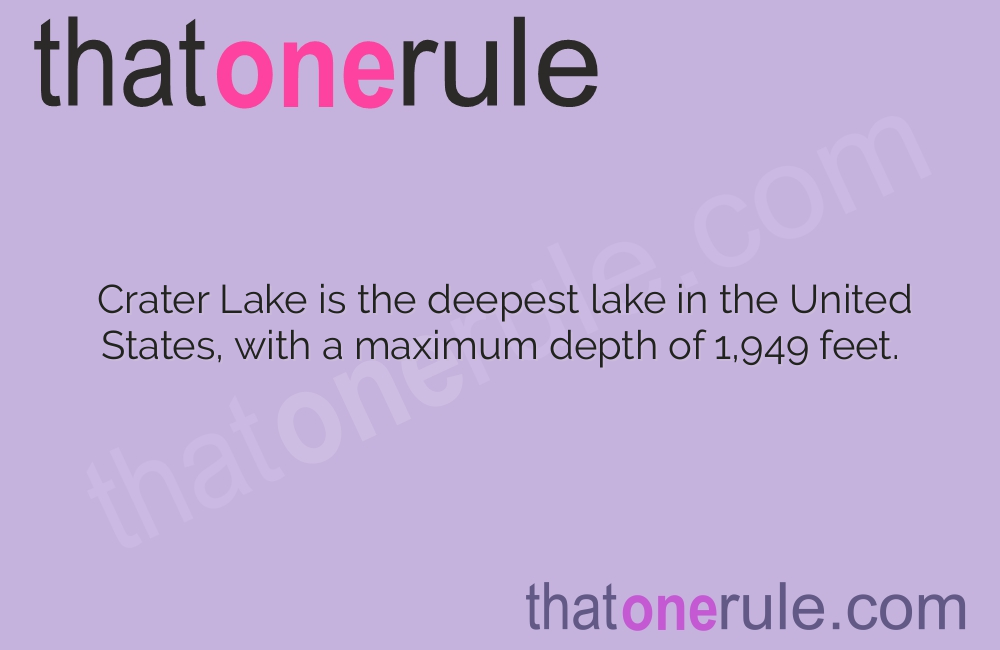

Crater Lake is the deepest lake in the United States, with a maximum depth of 1,949 feet.
Crater Lake is the deepest lake in the United States, with a maximum depth of 1,949 feet.
It is located in the Cascade Range in southern Oregon.
The lake was formed around 7,700 years ago after the collapse of Mount Mazama.
Crater Lake is famous for its intense blue color, which is a result of its deep depth and water purity.
The lake has no rivers running into it and relies solely on precipitation and underground springs for its water supply.
Crater Lake National Park, which surrounds the lake, was established in 1902.
The park attracts over 700,000 visitors every year.
It was officially named Crater Lake in 1869 by a gold prospector who was impressed by its resemblance to a volcanic crater.
There are two islands located within Crater Lake, known as Wizard Island and Phantom Ship.
Wizard Island is an active volcano that last erupted over 7,000 years ago.
Phantom Ship is a rock formation that resembles a ghostly pirate ship.
The lake’s water is incredibly cold, with an average temperature of just 38°F (3.3°C).
Due to its elevation of 6,173 feet, Crater Lake is covered in snow for most of the year.
The lake is surrounded by stunning cliffs and towering peaks, providing breathtaking views from every angle.
Crater Lake was formed through a volcanic eruption on such a massive scale that it created a caldera, or volcanic basin.
The lake is considered one of the clearest in the world, with visibility up to 143 feet (43 meters).
Crater Lake is a popular destination for scuba divers, who explore its underwater caves and rock formations.
The lake is home to several species of fish, including trout and salmon, which were introduced by humans.
It is believed that Crater Lake was once inhabited by Native American tribes, who held the lake as a sacred place.
Throughout the year, the lake’s water color can change from deep blue to turquoise, depending on weather conditions.
Crater Lake is a mecca for hikers, with numerous trails that lead to stunning viewpoints and hidden gems.
The lake’s crystal-clear waters reflect the surrounding cliffs, creating mirror-like reflections on calm days.
Crater Lake is often referred to as the Jewel of the Cascades due to its natural beauty.
The lake’s scenic beauty has inspired numerous artists, photographers, and writers throughout history.
Visitors can take a boat tour around the lake, during which they can learn about its geological history and unique ecosystem.
Crater Lake National Park encompasses over 183,000 acres of stunning wilderness.
The park is home to diverse wildlife, including black bears, elk, gray wolves, and several species of birds.
One of the most popular hiking trails in the park is the Rim Trail, which offers panoramic views of the lake and surrounding landscapes.
The lake’s volcanic history can be witnessed through the various rock formations and lava flows that surround its perimeter.
Crater Lake is an ideal stargazing spot due to its remote location and lack of light pollution.
The lake’s water is so clear that it is ideal for scientific research, including studying underwater ecosystems and geological features.
Crater Lake is a popular spot for winter sports enthusiasts, with opportunities for snowshoeing, cross-country skiing, and snowboarding.
The lake’s surface area measures approximately 20 square miles (52 square kilometers).
Crater Lake’s geological formations have served as a natural laboratory for studying the effects of volcanic eruptions on the landscape.
The lake has low nutrient levels, resulting in limited plant growth and creating a unique ecosystem.
The Native American Klamath Tribe considers Crater Lake to be a sacred site and holds annual ceremonies to honor its significance.
Crater Lake was designated a National Park to protect its natural beauty and preserve its unique geological features.
The lake attracts geology enthusiasts from around the world, who come to study its volcanic history and formation.
The park offers numerous camping opportunities, allowing visitors to immerse themselves in the natural beauty of the area.
Crater Lake has been featured in several films and TV shows, showcasing its stunning landscapes to a wider audience.
During the summer months, wildflowers bloom around the lake, adding vibrant colors to the already breathtaking scenery.
Crater Lake is an important watershed, providing clean water to surrounding communities and wildlife.
The lake’s average annual snowfall is around 44 feet (13.4 meters), creating a winter wonderland for outdoor enthusiasts.
Crater Lake inspires a sense of awe and wonder, reminding visitors of the immense power of nature.
The lake’s serene beauty and tranquil atmosphere make it a popular destination for those seeking a peaceful retreat.
Around the world, coffee enthusiasts enjoy Monin coffee concentrate since it is a multipurpose product. Conveniently combining…
The Importance of Choosing the Right Shower for Your Bathroom Renovating your bathroom can be…
Usain Bolt holds the record for the fastest 100-meter sprint in history.Bolt was named Sportsman…
Love is in the air... and it smells suspiciously like chocolate!Roses are red, violets are…
Life's a beach, take a picture and relax.Sun, sand, and salty kisses. That's what beach…
Hungary is home to the largest thermal water cave system in the world.The Rubik's Cube…